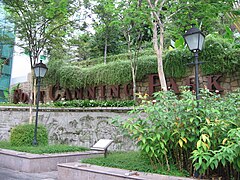Fort Canning Park
| Fort Canning | |
|---|---|

The entrance of Fort Canning Park at Hill Street.
|
|
| Type | City and heritage park |
| Location | Museum Planning Area, Singapore |
| Area | 18 hectares (180,000 m2) |
| Created | 1822 |
| Operated by | National Parks Board |
| Status | Opened |
| Website | Fort Canning Park |
Coordinates: 1°17′40″N 103°50′49″E / 1.29444°N 103.84694°E
Fort Canning (Malay: Bukit Larangan) is a small hill slightly more than 60 metres high in the southeast portion of the island city-state of Singapore, within the Central Area that forms Singapore's central business district. Although small in physical size, it has a long history intertwined with that of the city-state due to its location as the highest elevation within walking distance to the city's civic district within the Downtown Core. It is also a popular venue for music shows and concerts.
The Malays called the hill Bukit Larangan or Forbidden Hill since olden times. This is due to the belief that it is the place where the kings of ancient Singapore were laid to rest, and it was believed to be haunted. It was also believed that a palace once stood on the hill. A settlement on the hill in the 14th century was named Ban Zu (from the Malay pancur) by the Yuan dynasty traveller Wang Dayuan. Later Sir Stamford Raffles built his residence there, which was also used by other Residents and Governors. It became known as Government Hill until it was renamed Fort Canning in 1861 when a fort was built on the site. Today it is the location of the Fort Canning Park.
In around 1330, the Chinese traveller Wang Dayuan visited the island of Singapore, then called Temasek. Wang described in his work Daoyi Zhilüe the two distinct settlements of Temasek: Long Ya Men, and Ban Zu. Ban Zu, located on a hill behind Long Ya Men, is thought to be today's Fort Canning Hill. In contrast to the inhabitants of Long Ya Men who were described as being prone to acts of piracy, the people of Ban Zu were described as honest. The people were said to "wear their hair short, with turban of gold-brocaded satin", and they also wore red-coloured cloths and had a leader. It is now believed that the Fort Canning Hill area was once occupied by a palace with various buildings of political, religious and commercial significance.
...
Wikipedia
